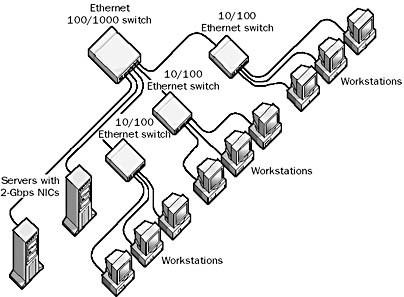Definition of Gigabit Ethernet in Network Encyclopedia.
What is Gigabit Ethernet?
Gigabit Ethernet is a type of Ethernet that allows the transmission of data at 1 Gbps (or 1000 Mbps) over both fiber-optic cabling and copper twisted-pair cabling. Gigabit Ethernet competes with Fiber Distributed Data Interface (FDDI) and Asynchronous Transfer Mode (ATM) technologies as an alternative for high-speed network backbones. Gigabit Ethernet is defined in the IEEE 802.3z and 802.3ab specifications.

How it works
Gigabit Ethernet supports a modified Carrier Sense Multiple Access with Collision Detection (CSMA/CD) media access method similar to those supported by previous versions of 10-Mbps Ethernet and 100-Mbps Fast Ethernet. Modifications to CSMA/CD for Gigabit Ethernet include extending the length of the carrier and slot times to pack out all frames to a minimum carrier length of 512 bytes. From the point of view of the MAC (media access control) interface, the minimum packet size still appears as 64 bytes. These modifications are performed to maintain a 200-meter-diameter topology for Gigabit Ethernet networks when a shared-media topology is used in half-duplex communications. The modifications can affect the performance of traffic involving smaller packets, but this is accommodated for by building a packet-bursting feature into Gigabit Ethernet that allows a station to take temporary control of the wire to send out a number of small packets. Note that these changes to CSMA/CD occur only during half-duplex communication. When using switched full-duplex connections, these changes do not apply.
Because CSMA/CD is used, Gigabit Ethernet can be viewed as a relatively easy upgrade path for network administrators familiar with 10BaseT and Fast Ethernet technologies. Gigabit Ethernet uses the same standard 802.3 framing structure of standard Ethernet, with frames between 64 and 1514 bytes in length. In standard half-duplex mode, Gigabit Ethernet supports speeds of 1 Gbps using CSMA/CD, but full-duplex versions support speeds of 2 Gbps for high-speed network backbones.
Gigabit Ethernet can be implemented in four different cabling or physical layer (PHY) options:
- 1000BaseCX: Uses 150-ohm balanced twinax cabling or shielded twisted-pair (STP) cabling over a maximum distance of 25 meters. This version is used primarily for connecting switches and routers in wiring closets. It uses Fibre Channel–based 8B/10B coding at a serial line rate of 1.25 Gbps.
- 1000BaseLX: Uses long wavelength transmissions over single-mode fiber-optic cabling. This version is used mainly for long cable runs of up to 5 kilometers.
- 1000BaseSX: Uses short wavelength transmissions over multimode fiber-optic cabling. This version is used mainly for short cable runs of up to 300 meters (over 50-micron fiber) and up to 550 meters (over 62.5-micron fiber).
- 1000BaseT: Uses twisted-pair category 5 cabling (four pairs of wires) over a maximum distance of 100 meters (maximum network diameter of 200 meters) and is intended mainly for connecting high-speed workstations to concentrators in nearby wiring closets.
Gigabit Ethernet networks can function as shared-media half-duplex networks using 1000-Mbps hubs, but they are usually implemented as switched full-duplex networks using 1000-Mbps Ethernet switches. Engineers currently envision two main uses for Gigabit Ethernet in corporate networking environments:
- High-speed switch-switch connections for network backbones. Typically you might connect several 100/1000-Mbps switches to provide Fast Ethernet islands joined by Gigabit Ethernet backbones. An alternative would be to connect several 10/100 switches to one 100/1000 switch.
- High-speed server-switch connections for server farms connected to server backbones. This configuration can provide users with 1-Gbps access to application or file servers.
Gigabit Ethernet might eventually be used for direct connections to high-speed user workstations, but at present this is a costly scenario to implement, and most applications can achieve sufficient bandwidth using only Fast Ethernet.
NOTE
Gigabit Ethernet is defined by the IEEE 802.3z specification. The Gigabit Ethernet Alliance is an open forum for promoting cooperation and standards in industry implementations of Gigabit Ethernet. Gigabit Ethernet standards were developed only recently and are now beginning to be widely implemented in high-speed networks.
TIP
Upgrading a Fast Ethernet backbone switch to a Gigabit Ethernet 100/1000-Mbps switch is straightforward and will enable you to connect high-speed server farms using Gigabit Ethernet network interface cards (NICs). Benefits include increased throughput and performance, more network segments, more bandwidth per segment, and a greater number of nodes per segment.